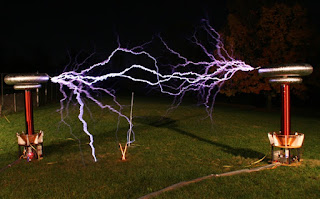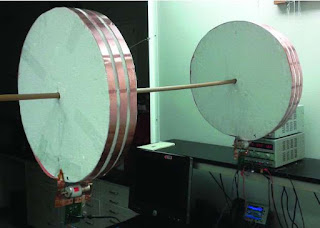Topics: Consumer Electronics, Economy, Electric Vehicles, Electrical Engineering, Jobs, Nicola Tesla
The Old
 |
| University of Illinois student Steve Ward and Fermilab senior technician Jeff Larson developed twin Tesla coils capable of emitting 12 feet (4 meters) of sparks. Credit: Fermilab |
Among his numerous innovations, Nikola Tesla dreamed of creating a way to supply power to the world without stringing wires across the globe. The inventor came close to accomplishing this when his "mad scientist" experiments with electricity led to his creation of the Tesla coil.
The first system that could wirelessly transmit electricity, the Tesla coil was a truly revolutionary invention. Early radio antennas and telegraphy used the invention, but variations of the coil can also do things that are just plain cool — like shoot lightning bolts, send electric currents through the body and create electron winds. [1]
The New
If electric cars could recharge while driving down a highway, it would virtually eliminate concerns about their range and lower their cost, perhaps making electricity the standard fuel for vehicles.
Now Stanford University scientists have overcome a major hurdle to such a future by wirelessly transmitting electricity to a nearby moving object. Their results are published in the June 15 edition of Nature.
"In addition to advancing the wireless charging of vehicles and personal devices like cellphones, our new technology may untether robotics in manufacturing, which also are on the move," said Shanhui Fan, a professor of electrical engineering and senior author of the study. "We still need to significantly increase the amount of electricity being transferred to charge electric cars, but we may not need to push the distance too much more."
The group built on existing technology developed in 2007 at MIT for transmitting electricity wirelessly over a distance of a few feet to a stationary object. In the new work, the team transmitted electricity wirelessly to a moving LED lightbulb. That demonstration only involved a 1-milliwatt charge, whereas electric cars often require tens of kilowatts to operate. The team is now working on greatly increasing the amount of electricity that can be transferred, and tweaking the system to extend the transfer distance and improve efficiency. [2]
"What's past is prologue." William Shakespeare
1. Wireless Electricity? How the Tesla Coil Works, Kelly Dickerson, Live Science
2. Wireless charging of moving electric vehicles overcomes major hurdle, Sid Assawaworrarit et al, Phys.org

Comments